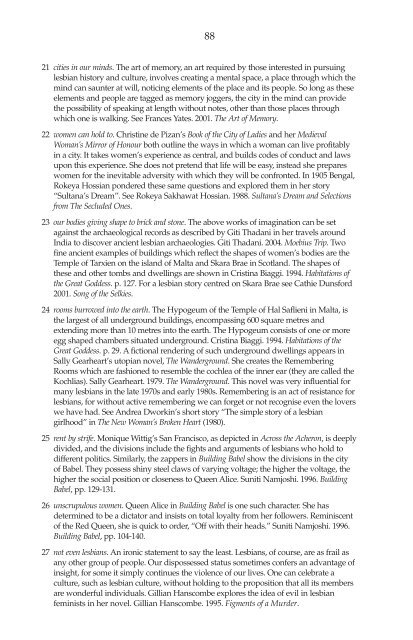Butterfly Effect - ressourcesfeministes
Butterfly Effect - ressourcesfeministes
Butterfly Effect - ressourcesfeministes
You also want an ePaper? Increase the reach of your titles
YUMPU automatically turns print PDFs into web optimized ePapers that Google loves.
88<br />
21 cities in our minds. The art of memory, an art required by those interested in pursuing<br />
lesbian history and culture, involves creating a mental space, a place through which the<br />
mind can saunter at will, noticing elements of the place and its people. So long as these<br />
elements and people are tagged as memory joggers, the city in the mind can provide<br />
the possibility of speaking at length without notes, other than those places through<br />
which one is walking. See Frances Yates. 2001. The Art of Memory.<br />
22 women can hold to. Christine de Pizan’s Book of the City of Ladies and her Medieval<br />
Woman’s Mirror of Honour both outline the ways in which a woman can live profitably<br />
in a city. It takes women’s experience as central, and builds codes of conduct and laws<br />
upon this experience. She does not pretend that life will be easy, instead she prepares<br />
women for the inevitable adversity with which they will be confronted. In 1905 Bengal,<br />
Rokeya Hossian pondered these same questions and explored them in her story<br />
“Sultana’s Dream”. See Rokeya Sakhawat Hossian. 1988. Sultana’s Dream and Selections<br />
from The Secluded Ones.<br />
23 our bodies giving shape to brick and stone. The above works of imagination can be set<br />
against the archaeological records as described by Giti Thadani in her travels around<br />
India to discover ancient lesbian archaeologies. Giti Thadani. 2004. Moebius Trip. Two<br />
fine ancient examples of buildings which reflect the shapes of women’s bodies are the<br />
Temple of Tarxien on the island of Malta and Skara Brae in Scotland. The shapes of<br />
these and other tombs and dwellings are shown in Cristina Biaggi. 1994. Habitations of<br />
the Great Goddess. p. 127. For a lesbian story centred on Skara Brae see Cathie Dunsford<br />
2001. Song of the Selkies.<br />
24 rooms burrowed into the earth. The Hypogeum of the Temple of Hal Saflieni in Malta, is<br />
the largest of all underground buildings, encompassing 600 square metres and<br />
extending more than 10 metres into the earth. The Hypogeum consists of one or more<br />
egg shaped chambers situated underground. Cristina Biaggi. 1994. Habitations of the<br />
Great Goddess. p. 29. A fictional rendering of such underground dwellings appears in<br />
Sally Gearheart’s utopian novel, The Wanderground. She creates the Remembering<br />
Rooms which are fashioned to resemble the cochlea of the inner ear (they are called the<br />
Kochlias). Sally Gearheart. 1979. The Wanderground. This novel was very influential for<br />
many lesbians in the late 1970s and early 1980s. Remembering is an act of resistance for<br />
lesbians, for without active remembering we can forget or not recognise even the lovers<br />
we have had. See Andrea Dworkin’s short story “The simple story of a lesbian<br />
girlhood” in The New Woman’s Broken Heart (1980).<br />
25 rent by strife. Monique Wittig’s San Francisco, as depicted in Across the Acheron, is deeply<br />
divided, and the divisions include the fights and arguments of lesbians who hold to<br />
different politics. Similarly, the zappers in Building Babel show the divisions in the city<br />
of Babel. They possess shiny steel claws of varying voltage; the higher the voltage, the<br />
higher the social position or closeness to Queen Alice. Suniti Namjoshi. 1996. Building<br />
Babel, pp. 129-131.<br />
26 unscrupulous women. Queen Alice in Building Babel is one such character. She has<br />
determined to be a dictator and insists on total loyalty from her followers. Reminiscent<br />
of the Red Queen, she is quick to order, “Off with their heads.” Suniti Namjoshi. 1996.<br />
Building Babel, pp. 104-140.<br />
27 not even lesbians. An ironic statement to say the least. Lesbians, of course, are as frail as<br />
any other group of people. Our dispossessed status sometimes confers an advantage of<br />
insight, for some it simply continues the violence of our lives. One can celebrate a<br />
culture, such as lesbian culture, without holding to the proposition that all its members<br />
are wonderful individuals. Gillian Hanscombe explores the idea of evil in lesbian<br />
feminists in her novel. Gillian Hanscombe. 1995. Figments of a Murder.

















